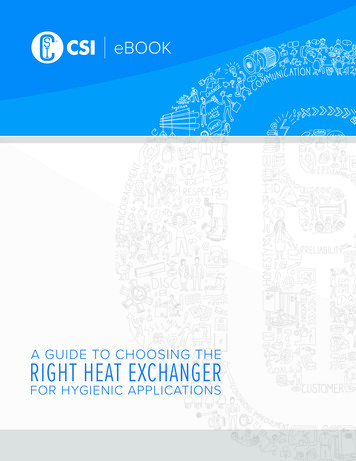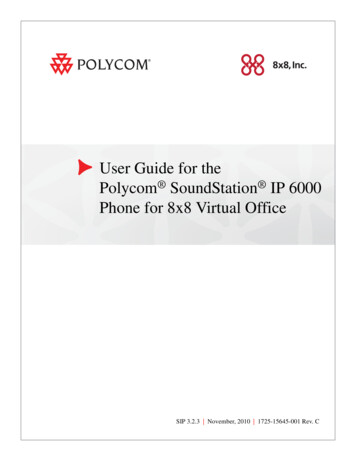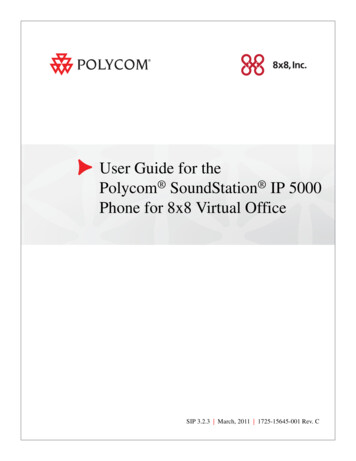
Transcription
eBOOKA GUIDE TO CHOOSING THERIGHTHEATEXCHANGERFOR HYGIENIC APPLICATIONS
TABLE OF CONTENTS.I NTRODUCTION.4–5Purpose of Heat Exchangers.4What Industries Use Heat Exchangers?.5 Food, Dairy and Beverage Applications.5 Pharmaceutical Applications.5TYPES OF HEAT EXCHANGERS. 6–11Plate and Frame. 6–7 Regenerative Heating Cooling.6 Plate and Gasket Technology. 7Shell and Tube.8–9 Double Tube Sheets.9Scraped Surface.10–11CIP AND HEAT EXCHANGERS. 12CLEANING AND MAINTENANCE.13–15Fouling and Aging. 13Types of Fouling. 13 Incrustation. 13 Scaling. 13 Sediment. 13Causes of Fouling. 13 Fluid Temperature. 13 Nature of Fluid. 13 Fluid Velocity. 132HEAT EXCHANGER GUIDE
When to Clean a Heat Exchanger. 14How to Get Rid of Fouling. 14The Importance of Flow Rate. 14Basic Chemical Cleaning Process. 14Selecting the Right Chemicals. 14Repair and Maintenance. 15 Regasketing. 15 Pressure Testing. 15 Hydrostatic Leaking Testing. 15 Backflushing. 15 Heat Exchanger Monitoring. 15NEXT STEPS. 16
INTRODUCTIONHeat exchangers come in a variety of designs forcontrolling temperatures in food, dairy, beverage,and pharmaceutical processing. Heat exchangershelp processors maintain efficient operations forpasteurization, sterilization, clean-in-place and otherhygienic operations.PLATE AND FRAME DESIGNSThis guide is designed for processors, productionmanagers, and mechanical engineers to help inthe heat exchanger selection process. We discussthree types of heat exchangers: plate and frame,shell and tube, and scraped surface. Dependingon your application, each design has advantagesand disadvantages and their own guidelines formaintaining peak performance.PURPOSE OF HEAT EXCHANGERSThe purpose of heat exchangers is to transfer heatbetween two or more fluids to regulate temperaturesduring food, dairy, beverage, and pharmaceuticalprocessing.SHELL AND TUBE DESIGNFor example heat exchangers can help makeproducts safe for consumption and extend shelf lifeby preventing growth of harmful microbes.Heat exchangers are the heart of every pasteurizersystem. They are designed to heat the product to adefined temperature at a specified flow rate. Theproduct is then held at that temperature for a fixedperiod of time.In some hygienic processes, ingredients must bemixed and heated to specific temperatures forproper mixing and activation on ingredients suchas starches.Finally, heat exchangers are designed to maximizeheat-transfer surface area between fluids while alsokeeping pressure drop to a minimum.SCRAPED SURFACE DESIGN4HEAT EXCHANGER GUIDE
WHAT INDUSTRIES USEHEAT EXCHANGERS?Food, dairy, beverage, and pharmaceutical industriesall use heat exchangers as part of their hygienicprocesses. To meet regulatory requirements,processes must be carefully controlled to maintainproper temperatures for pasteurization, fillingoperations, and food safety.Food, dairy, and beverage applicationsHeat exchangers can help reduce or eliminatemicrobials to make products safe for consumptionand to prevent spoilage.Heat exchangers also heat or cool products duringa variety of processing stages, including filling,cooking, and concentration. To meet processingrequirements for products of varying viscosities,heat exchangers use innovative designs to meetunique process requirements.For example, heat exchanger technology is vitalto maintaining proper product temperatures in avariety of applications: Milk and cheese milk pasteurization Ultra-high temperature sterilization Beverage and energy drink pasteurization Standard and pulpy juice pasteurization Beer wort heating and beer cooling Liquid egg processing Bottled water treatment Soups, sauces, and starch heating Ketchup and mustard heating and coolingPharmaceutical applicationsPharmaceutical applications require systemsthat maintain precise temperatures for specificdurations to ensure product safety and integrity.Heat exchangers are an effective method of thermalcontrol in a variety pharmaceutical processes: Water-for-injectionTemperature control for purified waterPoint of use coolersPharmaceutical combining and mixingIn all industries where heat exchangers are atwork, current technologies have several essentialfunctions: Maintaining consistent temperatures forpasteurization Heating cleaning fluids that remove residues fromsystems components Transferring heat without contaminating productsbeing heated Saving energy by re-using heated fluids to heatfluids in repeatable cycles Heating water for cleaning-in-place (CIP)
TYPES OF HEAT EXCHANGERSPLATE AND FRAMEPlate and frame designs include a series ofcorrugated parallel plates separated from eachother by gaskets. Gaskets control the flow of hotand cold fluids over the plate surfaces, allowingheat to transfer from hot to cold fluids of low tomedium viscosity.Gasket plate and frame heat exchangers are amongthe most efficient designs so are also among themost common designs in processing systems.Gaskets between plates guide the flow of productand heating/cooling fluids through alternatingchannels. As hot fluids pass over the plates, heattransfers from the hot to the cold side, decreasingthe temperature of the hot side and raising thetemperature of the cold side.Hot and cold fluidsalternate between platessealed with gaskets.Skid-mounted plateheat exchanger.Key to efficient operations, heat exchangers mustmaintain sufficient fluid velocity across plates totransfer heat while also controlling pressure dropsthat can disrupt operation. Systems typically employplate and frame heat exchangers for pasteurization,raw milk cooling, and CIP heating. Given theirsuitability for products with low to mid viscosityand few to no particulates, plate heat exchangersare commonly used for beverage, beer, wort, eggs,sauces, and most dairy processing.Regenerative heating and coolingIn milk processing, chilled milk is heated from, forexample, 4 C (39 F) to a pasteurization temperature of72 C (162 F) and held at that temperature for 15seconds and then chilled to 4 C (39 F) again.Heat always transfers from warmer substancesto colder ones, so during pasteurization, heatexchangers use heat from the pasteurized milkto warm the cold milk, which saves heatingand refrigeration energy. The process is calledregenerative heat exchange or heat recovery,typically reaching 90% and achieving up to 95%heat recovery from pasteurized milk. Recovery islower for higher-fat products such as cream andice cream mix. Regeneration has a positive impact6HEAT EXCHANGER GUIDEon energy savings, cost of ownership, and efficientoperation. Heat transfer occurs rapidly when thetemperature differential is high. As temperaturedifference decreases, the rate of transfer slowsdown and stops altogether when temperaturesequalize.Operators can have multiple sections on oneframe to control the flow of hot or cold fluids whenproducts have to be heated in one stage and thencooled in the next stage.For pasteurization, a multi-section heat exchangeruses connection plates configured by differentcorner connections for single, double, pass-throughor blind channels.
Plate and gasket technologyThe design of the corrugated plates creates a largebut compact total surface area for transferringheat. The heat transfer area of the plates featuresa herringbone pattern that creates high turbulencewhich increases heat transfer and aids cleaningduring CIP.ADVANTAGES & DISADVANTAGESOF PLATE AND FRAMEADVANTAGES Relatively inexpensive compared withother designsThe plate distribution area ensures an even flow offluid over the entire plate to maximize heat transfer.An optimized flow distribution also reduces uneventemperature zones that contribute to fouling. Excellent CIP-abilityWhile the narrow flow path of plate heat exchangerscreates efficient heat exchange, the narrow pathalso limits its ability to process fluids to thosewith low to medium viscosity and few suspendedparticles that can result in fouling from particulatesgetting caught on plate contact points. Replaceable gasketsFor fluids that contain particles, two solutions areavailable. Both allow particles to pass through whileminimizing fouling: A low contact point, wide-stream plate that canrun product with more particulate Wide-gap plates that can run more and largerparticulatePLATE AND FRAME VERSATILEBecause plate and frame heat exchangers aredesigned to increase or decrease in capacitydepending on application, they are among themost versatile heat exchangers available. They’redesigned for easy addition or removal of plates asrequirements change.In addition to variations in height and width thataccommodate installation and system integration,plate and frame heat exchangers can scale in depthas system capacities change. Easy to clean and maintain High heat regeneration High turbulence Easy to increase/decrease capacity Smaller footprint than shell-and-tubedesignsDISADVANTAGES Relatively low operating temperature Higher maintenance cost than tubulardesigns, due to gaskets Not for use with highly viscous or largeparticulate fluids
TYPES OF HEAT EXCHANGERSSHELL AND TUBEInstead of transferring heat through parallel plates,shell and tube heat exchangers transfer heatbetween a bundle of tubes surrounded by a largeshell vessel. Tubes enable processing of fluidsthat are more viscous or contain more particulateor larger matter. Fluids that run through the tubesexchange heat with fluids that run over the tubescontained by the shell.Because the diameter of tubes is typically greaterthan the gap between plates in plate heat exchangers,shell and tube exchangers are suited to applicationsin which product is more viscous (resistant to flow),or contains high-density particulates. Maximumparticle size depends on tube diameter. Tubularheat exchangers can typically run longer betweencleanings than plate heat exchangers in ultra-hightemperature applications.A concentric tubular heat exchanger features tubesof different diameters positioned concentricallyinside of each other, which is especially efficient inheating or cooling because heating/cooling fluidsflow on both sides of the product tubes. Producttubes can be sized to meet the requirements forShell and tube counter-flowproduces efficient heat transfer.8HEAT EXCHANGER GUIDEviscosity and particulates. A concentric tube isespecially suited to high-viscosity non-Newtonianfluids whose viscosity changes under pressure(shampoo, nail polish, ketchup).As with other heat exchanger designs, shell andtube exchangers are set up to have product andheating/cooling fluids flow in opposite directions.For example, cold product fluid travels from right toleft in the heat exchanger while the warming fluidtravels from left to right over the product tubes.The counter-flow configuration takes advantageof maximized temperature differences for moreefficient heat transfer.One manufacturer’s Pharma-line of shell and tubeheat exchangers operates at pressures of up to 10bar and operating temperatures of 150 C (302 F).Typical applications for the shell-and-tube heatexchangers include systems that process water(for injection or purification, for example), and CIPsystems.Double Tube SheetsIn pharmaceutical applications, the risk of mixingbetween product and the heating or cooling medium
is eliminated thanks to a double tube sheet design.Product flows in the tubes while the service fluidflows around the tubes inside the shell. Servicefluid is sealed in the shell by one tube sheet and asecond tube sheet seals the product.Heat exchangers with double tube sheets makeleaks easy to spot because they appear at the jointin the outer tube plate. The heating fluid is sealedin the shell by the first tube sheet and the secondtube sheet seals the product. In the event of a leak,the leakage of either fluid is easily visually detected.Shell and tube heat exchangers are especiallyeffective in the pharmaceutical industry whereproduct hygiene is paramount and demand forisolating products, purified water, and water forinjection from heating/cooling fluids is especiallyhigh. To meet the industry’s demands, high-qualitytubular heat exchangers control microbe growthand prevent cross-contamination.Some of the newest tube-in-tube designs forpharmaceutical applications feature high shearforce and turbulence to maintain efficient transfer ofheat while reducing bio-film.Smaller, lighter-weight heat exchangers designedfor tighter spaces can be effective substitutesfor larger tube heat exchangers. They feature thesame hot and cold fluid flows through alternatingchannels that create high turbulence for high heattransfer efficiency while using 50–80% less heattransfer area.SHELL AND TUBE SIMPLESimple, low-maintenance in-line heating option.While these units are widely used for viscousproducts with particulates in food, dairy, andbeverage markets, they are typically found inpharmaceutical applications where completedrainability is required. Shell-and-tube designs areless efficient thermally, requiring more surface areaand floor space. However, their designs can handlemore and larger particulate, higher temperatures,and pressures than plate heat exchangers.ADVANTAGES & DISADVANTAGESOF SHELL AND TUBEADVANTAGES Excellent CIP-ability Medium heat regeneration Lower maintenance cost than scrapedsurface designs For use with moderately viscous productsor products with particulate Easy to spot leaks Relatively inexpensive compared withother designsDISADVANTAGES Higher maintenance cost than plate heatexchangers Not for use with highly viscous products orproduct with large particulates Difficult to expand capacity Larger footprint than plate-and-framedesigns
TYPES OF HEAT EXCHANGERSSCRAPED SURFACE EXCHANGERSSome processes require heat transfer that preventsfouling from viscous and sticky products. In thoseprocesses, scraped surface heat exchangers arethe right choice because of their ability to processfluids that include a high number of particulates orhigh viscosity. Scraped surface heat exchangers areoften more expensive than other exchangers, butwork more efficiently in some applications whereother options would be ineffective.In scraped-surface heat exchanger applications, theproduct enters the cylinder at one end and flows tothe other end. Units may be positioned vertically orhorizontally. The heating or cooling medium travelsthrough a narrow ring-shaped (annular) channel.Scraped surface heat exchangers are common inthe food and personal care industries. Ensuringcontinuous production requires uniform heattransfer, but the consistency or content of somefood products hinders efficient heat transfer.Scraped-surface heat exchangers meet the needfor efficiency by keeping product off the walls andin the mix where it belongs.Typical processing applications: KetchupMayonnaiseSpreads and fillingsSauces and puddingsBaby foodSkin lotionsShampoos10HEAT EXCHANGER GUIDEScraped surface exchangers are fitted with rotatingblades that remove product from the cylinder wall tomaintain consistent heat transfer.They’re designed specifically for gentle producthandling to avoid interference with product qualityand consistency.Scraped surface exchangers are typically mountedvertically. Inside, an electric motor turns a rotorfitted with scraping blades. To prevent damageto product, rotors and product move through theheat exchanger in the same direction, with productentering at the bottom and exiting at the top.
SCRAPED-SURFACE DOUBLE-DUTYScraped-surface heat exchangers add value tosystems by handling a wide variety of products.Phase changes are also possible, allowingevaporation to concentrate highly viscous products.Typical applications include processing of ketchup,mayonnaise, hummus, chocolate spreads, fruitpie fillings, gravies and sauces, whipped/aeratedproducts, peanut butter, pizza sauces, puddings,salad dressings, and baby food.Rotating blades continuously remove product fromthe cylinder wall to ensure uniform heat transfer. Theproduct enters the cylinder in a corkscrew patternin the same direction as the rotating scrapingassembly. The design of scraped surface heatexchangers preserves product quality by providinggentler product handling. Both product flow androtor speed can be adjusted to suit the properties ofthe product in the cylinder.ADVANTAGES & DISADVANTAGESOF SCRAPED SURFACEADVANTAGES Very effective with viscous products orproduct with large particulate fluids High operating pressure Works in horizontal or vertical positionDISADVANTAGES Relatively more expensive than otherdesigns Moderately CIPable Difficult to expand capacity No heat regenerationSkid-mounted heatexchangers minimizeequipment footprint.
CIP AND HEAT EXCHANGERSIn addition to heating processed foods, beverages,and pharmaceuticals, heat exchangers heatthe water and chemicals used for CIP functions.CIP systems enable cleaning and sanitizing ofprocessing systems to industry standards withoutrequiring disassembly of system components.Accordingly, heat exchangers are also designed tobe cleaned in place.CIP systems connect directly to heat exchangerconnections and circulate a mixture of heated nontoxic cleaning agents that effectively remove scale,product deposits, and bio-fouling to clean processsurfaces and restore performance of systemcomponents. Custom fabricated CIP systems aresuitable for very large heat exchangers, whichrequire expertly engineered CIP solutions.During CIP, the cleaning solution is pumpedthrough the heat exchanger, where it is heated tothe required temperature and where plate designscreate turbulence that aids in plate cleaning. Thesolution is then routed to the target system and backto the circulation tank included in the CIP module.Processing at high temperatures–with hard water orhigh pH levels–increases risks of fouling or scaling,so cleaning is required to maintain efficiency. CIPequipment circulates cleaning chemicals and rinsesto flush interior surfaces of heat exchangers withouthaving to disassemble them.After each cleaning phase, the cleaning solutionis routed to a drain or back to the detergent tankfor re-use. A normal sequence could include initialwater rinse, lye cleaning, intermediate water rinse,acid cleaning, and final water rinse followed bychemical or hot water disinfection. The temperature,flow and detergent concentration in the CIP returnline are automatically controlled throughout thecleaning cycle.While performing their functions in processing andCIP, heat exchangers help reduce utility consumptionby conserving water, electricity, and steam.In all sanitary applications including pharmaceuticalsand food processing, cleaning and sanitation mustoccur at sufficient intervals to prevent equipmentfouling, reactions, and cross contamination.Temperature regulation is a key factor in maintainingtemperatures during each interval.12HEAT EXCHANGER GUIDE
CLEANING AND MAINTENANCEFOULING AND AGINGDegraded heat exchanger performance from foulingor aging results in extra operating and energy coststo compensate for gaps in the target temperature.Cleaning and maintenance of heat exchangers istherefore important to keeping systems runningefficiently. Regular maintenance ensures equipmentis in working condition and helps prevent emergencyrepairs. The cost of cleaning a heat exchanger issmall compared to the cost of lost production shoulda heat exchanger require an unscheduled shutdown.Product or chemical deposits on heat-transfersurfaces lessen an exchanger’s heat-transfercapacity and must be cleaned away regularly tomaintain high performance and prevent disruptionof processing.Heat exchanger fouling, or the unwantedaccumulation of deposits on heat-transfer surfaces,can result in several costs: Production loss from shutdowns Maintenance costs for removal ofheavy fouling deposits Replacement of plugged equipment Increased pressure drops Decreased regeneration efficiencyTYPES OF FOULINGThe most commonly occurring types of foulingand aging in hygienic processing fall into fourmain types:Incrustation: The accumulation of a crust or coatingof processed fluids, minerals, or cleaning agents onthe surface of heat exchanger parts.Scaling: A type of incrustation caused by calciumcarbonate, calcium sulphate, and silicates.Sediment: Comes from corrosion products, metaloxides, silt, alumina, and diatomic organisms(microalgae) and their excrement. Sedimentaccumulates because heat releases minerals andother particles from fluids during processing cycles,and those settle and deposit on heat transfersurfaces.Biological growth: Sources of biological foulinginclude bacteria, nematodes, and protozoa.Scaling on heat exchanger tubesCAUSES OF FOULINGFluid temperatureWater can produce scaling from minerals suchas calcium carbonate (CaCO3). Salts deposit onthe heat exchanger surface with increases intemperature. Similarly with increase in temperatureduring food processing, biological growth can occur.Nature of the fluidDuring milk processing, for example, fouling leadsto a rise in pressure drop across the exchanger byreducing flow from the growth of deposits. In dairyindustries, proteins, fats, sugars, and minerals frommilk and dairy products can come out of solution,deposit on heat exchanger surfaces, and foulchannels.Fluid velocityIn most cases, fouling decreases at higher fluidvelocities because increasing flow velocityincreases the fluid shear stress, which causes moreremoval of deposits.But for stronger deposits, increasing the flowvelocity beyond a particular point may not decreasefouling significantly, and in the case of very strongdeposits, increasing flow velocity may not haveany effect.
CLEANING AND MAINTENANCEWHEN TO CLEAN A HEAT EXCHANGERBASIC CHEMICAL CLEANING PROCESSYou can tell when it’s time to clean your heatexchanger when the exchanger doesn’t achieve thecorrect product temperatures for heating or cooling.The incorrect temperatures result from plate surfacefouling that reduces temperature transfer. So theanswers to the question, “how often should heatexchangers be cleaned?” Is “often enough tomaintain high performance.”Chemical cleaning in CIP offers several advantages:You might also see pressure drops higher thanspecified because fouling is constricting the channelpassage and increasing fluid velocity.HOW TO GET RID OF FOULINGCIP equipment can clean fouling without disassembly.Using a combination of time, temperature andconcentration, CIP provides both chemical andmechanical cleaning to the heat exchanger. Ifsystem configuration prohibits CIP, operators mustperform manual cleaning.CIP cleaning of heat exchangers typically includesseveral goals: Cleaning lime deposits Passivating surfaces to reduce susceptibilityto corrosion Neutralizing cleaning chemicals before drainingTHE IMPORTANCE OF FLOW RATEThe proper flow rate ensures effective mechanicalaction of fluids during cleaning. Some manufacturersrecommend a minimum of 1 ft/sec velocity acrossheat exchanger plates, but requirements vary bymanufacturer.The flow rate during the cleaning of the productside should always be at least the same as theproduction’s flow rate. An increased flow rate maybe required in some cases—for example, in milksterilization and the processing of viscous liquids orliquids containing particles.14HEAT EXCHANGER GUIDE Quicker cleaning process Less labor intensity Cleans build up that can’t be removed throughmechanical action componentsOperators typically follow four steps in the chemicalcleaning process in CIP: Alkaline clean: removes build-up of organicmaterials Rinse: generally completed with a high-flow waterflusher to remove loose debris and remainingresidue from the alkaline step Acid cleaning: helps dissolve and soften foulingmaterials more deeply Final rinseRecommended limits for cleaning solutions: 5% by volume caustic at a maximum 70 C (160 F) 0.5% by weight acid solution at a maximumof 70 C (160 F)Manufacturers can provide more detailedinformation about cleaning and sterilization forspecific equipment.SELECTING THE RIGHT CHEMICALSUsing the correct chemicals for cleaning heatexchangers is important to ensure proper cleaningand to avoid damaging exchanger components.Cleaning agents must be compatible with boththe plate metal and the composition of gaskets.For example, the following solvents and othercleaning agents can damage heat exchanger platesand gaskets: Ketones such as Acetone, Methyletylketone,Methylisobutylketone Esters such as Ethylacetate, Butylacetate Halogenated hydrocarbons such as Chlorothene,Carbon tetrachloride, Freons Aromatics such as Benzene, Toluene
Never use hydrochloric acid with stainless steel ortitanium plates because the acid causes generalcorrosion, pitting, and stress corrosion cracking.The new gasket is
three types of heat exchangers: plate and frame, shell and tube, and scraped surface. Depending on your application, each design has advantages and disadvantages and their own guidelines for maintaining peak performance. PURPOSE OF HEAT EXCHANGERS The purpose of heat exchangers is to transfer











